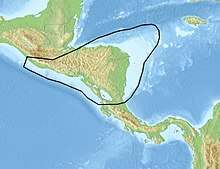Chortis Block
The Chortis Block is a 400–600 km (250–370 mi)-wide continental fragment in Central America (Honduras, Nicaragua, El Salvador, Guatemala, and the off-shore Nicaragua Rise) located in the northwest corner of the oceanic Caribbean Plate.

Extent
The northern margin of the Chortis Block is the Motagua-Polochic fault of the North American-Caribbean strike-slip boundary. The Cocos/Farallon Plate subducts beneath its western margin resulting in the Middle America Trench and the Central America Volcanic Arc. Miocene-Holocene-aged rifts in the northern and western Chortis Block is the result of slow internal deformation. The southern and eastern extent is roughly the Nicaragua-Costa Rica border and the offshore Hess Escarpment. [1]
The Chortis Block can be subdivided into several terranes, the names and extents of which varies considerably between different authors.[2]
Tectonic history
Gondwanan origin
During the Late Neoproterozoic-Early Palaeozoic the Chortis Block was probably located on the northern shores of what is now Colombia, then the northern margin of the Amazonian Craton, with an ocean separating it and the other blocks from core North America or Laurentia.[3] Before the Early Carboniferous formation of Pangaea the Chortis Block thus formed part of the northern margin of Gondwana, located south of other Peri-Gondwanan terranes such as Oaxaca, Carolina, Yucatán, and Florida.[4] These blocks either escaped the Laurussia-Gondwana collision and were broken off Gondwana later,[4] or were accreted to Laurentia during the collision.[3]
Laurentian origin
Located in a largely unpopulated, mountainous region, the geology of which is poorly known, the Chortis Block is the only Precambrian-Palaeozoic continental crust on the Caribbean Plate and even its origin within North America has remained enigmatic and disputed for decades.[5]
Three models have been proposed for the origin of the Chortis Block:[6]
- According to the first, most widely accepted model, the Chortis Block moved c. 1,100 km (680 mi) eastward and rotated counterclockwise 30-40° along the Cayman-Motagua-Polochic fault system from its Middle Eocene location off the southwestern coast of Mexico. This model is supported by matching lineations in the Chortis Block and Mexico.
- A second model proposes that the Chortis Block originated in the eastern Pacific Ocean 700–800 km (430–500 mi) south of the Cayman-Motagua-Polochic fault. From this remote location it has moved 1,100 km (680 mi) while rotating 40° clockwise.[7] This rotation is, however, not supported by geological observations.
- A third, in situ model suggests that the Chortis Block has been located more or less just south of Mexico since North and South America separated in the Late Jurassic.[8] This model is based on matching lineaments in the Chortis Block and the areas surrounding it.
References
Notes
- Rogers, Mann & Emmet 2007, Geologic and tectonic setting of the Chortis Block, p. 71
- Compare for example Ortega-Gutiérrez et al. 2007, Fig. 9 and Rogers, Mann & Emmet 2007, Fig. 1
- Murphy et al. 2004, Fig. 2a-c, p. 662; Middle American terranes, p. 667
- Blakey 2003, Convergence: Early and Middle Paleozoic, pp. 451, 453; Assembly of Western Pangaea: Carboniferous–Permian, pp. 453–454
- Rogers, Mann & Emmet 2007, Tectonic Significance, p. 66
- Rogers, Mann & Emmet 2007, Previous Tectonic Models for the Origin of the Chortis Block, pp. 66-67
- See for example Keppie & Morán-Zenteno 2005
- See for example James 2006
Sources
- Blakey, R. C. (2003). "Carboniferous–Permian paleogeography of the assembly of Pangaea". In Wong, Th. E. (ed.). Proceedings of the XVth International Congress on Carboniferous and Permian Stratigraphy. Utrecht (Vol. 10, p. 16). Utrecht, the Netherlands: Royal Netherlands Academy of Arts and Sciences.CS1 maint: ref=harv (link)
- Keppie, J. D.; Morán-Zenteno, D. J. (2005). "Tectonic implications of alternative Cenozoic reconstructions for southern Mexico and the Chortis Block" (PDF). International Geology Review. 47 (5): 473–491. doi:10.2747/0020-6814.47.5.473. Retrieved 4 March 2018.CS1 maint: ref=harv (link)
- James, K. (2006). "Arguments for and against the Pacific origin of the Caribbean Plate: discussion, finding for an inter-American origin" (PDF). Geologica Acta: an international earth science journal. 4 (1–2): 279–302. Retrieved 4 March 2018.CS1 maint: ref=harv (link)
- Murphy, J. B.; Pisarevsky, S. A.; Nance, R. D.; Keppie, J. D. (2004). "Neoproterozoic—Early Paleozoic evolution of peri-Gondwanan terranes: implications for Laurentia-Gondwana connections" (PDF). International Journal of Earth Sciences. 93 (5): 659–682. doi:10.1007/s00531-004-0412-9. Retrieved 4 March 2018.CS1 maint: ref=harv (link)
- Ortega-Gutiérrez, F.; Solari, L. A.; Ortega-Obregón, C.; Elías-Herrera, M.; Martens, U.; Morán-Icál, S.; Chiquín, M.; Keppie, J. D.; Torres de León, R.; Schaaf, P. (2007). "The Maya-Chortís boundary: a tectonostratigraphic approach" (PDF). International Geology Review. 49 (11): 996–1024. doi:10.2747/0020-6814.49.11.996. Retrieved 4 March 2018.CS1 maint: ref=harv (link)
- Rogers, R. D.; Mann, P.; Emmet, P. A. (2007). "Tectonic terranes of the Chortis block based on integration of regional aeromagnetic and geologic data" (PDF). In Mann, P. (ed.). Geologic and Tectonic Development of the Caribbean Plate Boundary in Northern Central America. Special Papers-Geological Society of America. 428. pp. 66–88. doi:10.1130/2007.2428(04). ISBN 9780813724287. Retrieved 4 March 2018.CS1 maint: ref=harv (link)